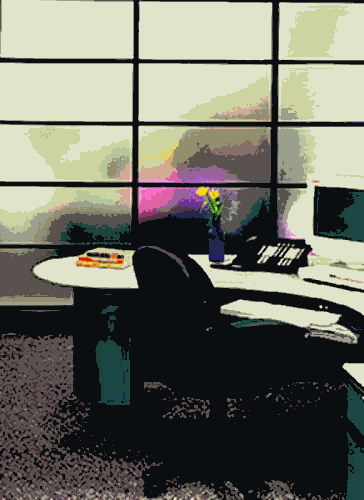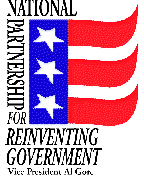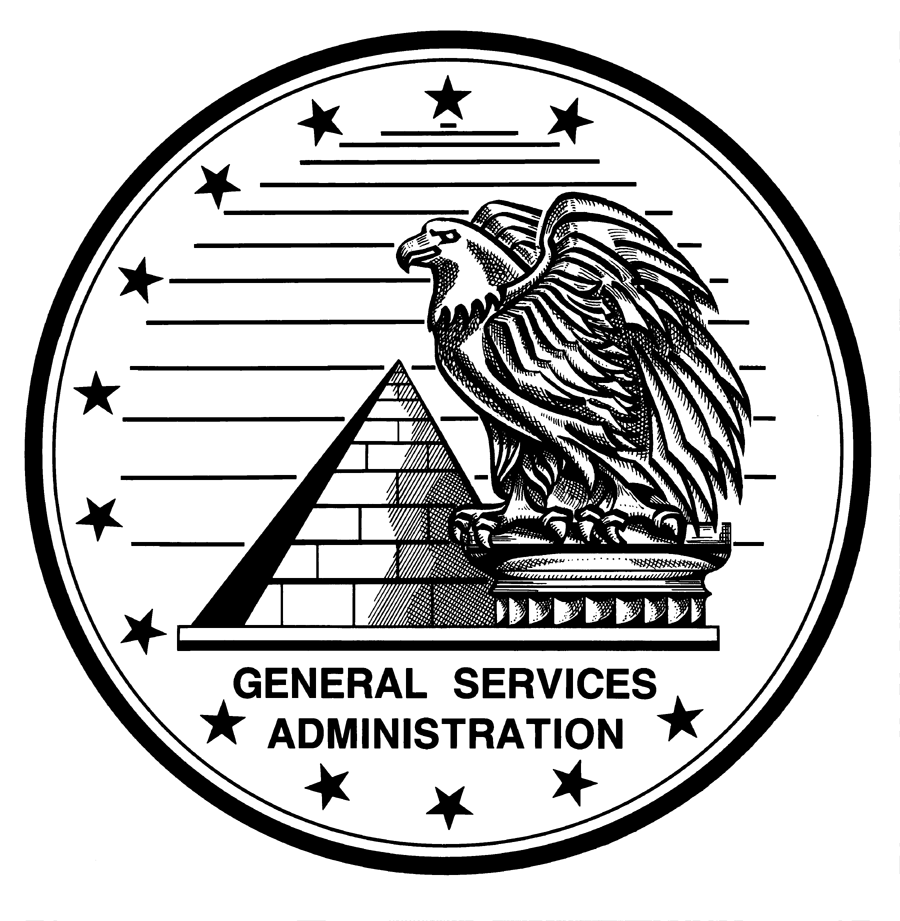Archive
THE NEW WORK ENVIRONMENT

General Services Administration
National Partnership
for Reinventing Government
The New Work
Environment
An effective working relationship was established between the Vice President’s National Partnership for Reinventing Government (NPR) and the General Services Administration (GSA) incorporating the latest thinking within GSA and the private sector on innovative workplace practices: collaborative working, maximizing human performance, and employee mobility.
The GSA incorporated these innovations into a new work environment for the NPR at their offices at 750 17th Street, NW, Washington, DC. With current staffing levels of approximately 40 and anticipated growth of up to a total of 80 individuals, the office was designed so that employees could be accommodated whether in their downtown Washington office, their homes, or remote locations.
The New Work Environment offers an overview of
the accomplishments to date. We continue to strive to improve the work
environment: changes have been incorporated, new furniture will be beta-tested,
and telecommunications improvements are being made. This is another example of
an ongoing partnership between the General Services Administration and its Federal
customers.
The New Work Environment


The Concept
The main theme of the new work environment for the Vice President's National Partnership for Reinventing Government (NPR) is interactivity. The office space serves as the facilitator of collaboration, communication, and productivity. The work environment becomes a set of flexible stages for interaction linked by the movement of people, ideas, and information. Furniture, space, and electronic technology stimulate collaboration, creativity and work efficiency.
The NPR worked with the General Services Administration (GSA) to translate their work criteria of teaming, workspace flexibility, and telecommuting into a new office environment. Because the NPR’s new mission is to create partnerships with federal agencies to work better, cost less, and get results, the GSA’s task was to understand these issues and align the work environment design efforts to meet their needs.
Since the NPR is an interagency task force, the organization draws its representatives from numerous departments, agencies, and commissions of the Federal Government. The NPR workforce is highly transient and is not rigidly tied to a particular location or organization. Additionally, the NPR’s workload is highly variable: the workforce can change in size practically overnight. By rethinking traditional office design, the GSA increased the flexibility and capacity of the work environment to accommodate the fluctuations of personnel without requiring additional leased space. The total effect of this unique office concept built by the GSA is to provide an environment that supports teaming and collaboration. Tasks requiring individual concentrated attention will be accomplished offsite in a telecommuting setting.
The Physical Environment
The physical space layout is built around the new work patterns and organizational practices of the NPR. The space is an open office environment with large teaming areas to accommodate the eight NPR teams. The most revolutionary design feature is a drastic reduction in personal space and an increase in flexible team space. The furnishings for individual team members are clustered around the teaming area, and each team is responsible for the management of its space. Individual workspaces will remain generic in order to allow for hoteling so that more than one employee may use the workspace.
All the teaming areas are multifunctional and have furnishings that can be configured in a multitude of ways. Conference tables can be arranged to facilitate a large meeting or broken apart to make several small or individual tables. Spaces can be physically separated with mobile partitions. When staffing is at a high peak, teaming areas and their furnishings can be turned into individual workstations.
The concept of "displayed thinking" is utilized throughout the office. Displayed thinking is the process of displaying work products, team-brainstorming lists, or other materials in the open for all team members to comment, modify, or correct. Therefore, the wall treatments on many of the surfaces within the office space are either tackable surfaces or dry-erase boards.
The Virtual Environment
While the physical environment allows for teaming and human interaction, the NPR organization will rely heavily on telecommunications and information technology to provide the work environment for individual employees. The goal of the technology provided to the NPR by the GSA is to allow employees to function from a multitude of locations, in other words, to become "virtual" employees. The key to the virtual office is remote access to information and the ability to manipulate information just as easily as if in the physical office environment. To that end, the NPR employees have been provided with a computing and telecommunications platform to allow them to be fully mobile.
The phone system selected for NPR is the GSA's Washington Interagency Telecommunications System (WITS). Utilizing the standard calling features available from WITS, the GSA has customized a solution for the NPR. Phone numbers have been assigned to people, not to phone instruments. This will allow NPR employees to forward their calls to any phone in the office space, at home, while on travel, or to their cellular phone or pager, and forwarding can be done from anywhere they may be. The NPR has also been provided with a highly sophisticated voice mail system, Caller ID and 3-way conferencing capabilities.
Remote workers, team members from other Federal Government agencies, or employees who frequently travel, will accomplish many of the NPR's initiatives. To support this, the GSA has provided an information technology infrastructure solution which incorporates hardware and software products tailored to the mobile worker. Digital remote computer network access for up to 48 employees is provided by a remote access server, and a new messaging platform has been adopted for electronic mail and appointment calendar coordination. Also, a new wireless local area network will enhance employee mobility.
Seamless Service Delivery
Much is unique and forward thinking about the NPR’s new office environment, including the method by which GSA has delivered its services to the customer. The NPR had no interest in doing business with a multitude of separate organizations and vendors. Early on, the GSA decided to provide the full range of services described above as a turn-key package, acting as the integrator and project manager and providing to the NPR one level bill on a yearly basis for the entire cost of the service. The entire package, from rent and construction to furniture and computer leasing, telecommunications and network services are all provided by the GSA for a yearly, firm fixed price to the NPR. This allows the NPR to concentrate on its core mission of reinventing government rather than spend numerous staff hours on purchasing, administration, and other back-office activities. It also provides the NPR with a fixed, predictable cost of operations over the coming three years.
By working closely internally, integrating service delivery, and working
hand-in-hand with the NPR customer, the GSA has not only provided quality goods and services
at the best possible price, but has created a new work environment for the NPR that is greater
than the sum of the parts and a true value to America. We believe that this partnership between
the GSA and the NPR has truly demonstrated
America@Our Best.
Displayed Thinking - A process of collaboration whereby work products,
brainstorming lists, or other materials are displayed in a common area for all team members
to comment, modify, or correct.
Telecommuting or Work Anywhere - Having the necessary computer and
telecommunications support to work from home, airport, hotel, local library or anywhere
one chooses.
Flexible Workplace - A workplace designed to adapt to a flexible
organization. The workplace can be generic and static systems furniture and staff
moves as needed, or the furniture can be flexible and move to accommodate staff changes.
Teaming - Staff working in an environment that builds on the
strengths of each member and supports collaborative thinking and brainstorming.
Improved Productivity – Improved cycle time, improved morale,
less down time, reliability of systems, improved aesthetics, spatial equity, automation.
Partnership – Collaboration with Federal Government agencies that
interact the most with citizens and the design of innovative new ways for all parts of our
government to listen to their customers and deliver hassle free service.
Haworth
Herman Miller
Nelson B. Alcalde
Juanita Blassingame
Concept Development by theSpecifications Furniture Steelcase
Stationary Systems Furniture -- "Context"
Task Chairs -- "Protégé"
Conference Room Chairs -- "Sensor"
Side/Stackable Chairs -- "Player"
Reception Room Chairs -- "Migration"
Mobile Tables -- "Activity Group"
Mobile Workstations -- "Crossings"
Mobile Tables -- "Crossings"
Stationary Systems Furniture -- "Premise"
Task Chairs -- "Improv"
Mobile Workstations -- "Ethos Space"
Mobile Tables -- "Ethos Space"
Task Chairs -- "Aeron"
Lateral Electronic Files -- "Meridian"
Demountable Walls -- "V-Wall"Electronic
File
System Space Saver Files Wall Systems Demountable Walls -- Herman Miller "Meridian"
Tackable Wall Systems -- Maharan "Tek-Wall" TelephoneService Local -- Washington Interagency Telecommunications System
Long Distance -- FTS2000Telephone Sets Phone Sets -- Analog Nortel Meridian 9316
Attendant Phone -- Lucent Technologies 8525 ISDN Voicemail WITS Octel Information
Technology
Infrastructure
Remote Access Server -- Ascend
Messaging Platform -- Microsoft Exchange
Network Services -- Microsoft Windows NT
Personal Computers and Laptops -- Compaq
Onsite Support of Information Technology
Systems -- 3H Technology, LLC
Wireless LAN System -- JVC
U.S. General Services administration
David J. Barram
Administrator
Regional Administrator
National Capital Region
Tom Catlin
Project Coordinator
(202) 708-5927
tom.catlin@gsa.gov
Lois Bennett
Facility Design
(202) 401-1666
lois.bennett@gsa.gov
David Riggs
Information Technology
(202) 708-6100
dave.riggs@gsa.gov
Office Furnishings
(703) 305-7020
juanita.blassingame@gsa.gov
Trisha Sitnik
Telecommunications
(202) 708-6100
trish.sitnik@gsa.gov